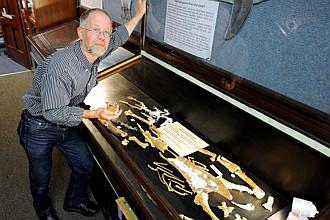A tall and elegant race of penguins inhabited what is now New Zealand 25 million years ago, scientists have learned.
The bird stood over 4ft tall and was slimmer than modern penguins, with a long beak and flippers.

A reconstruction of the penguin was made from two separate fossil skeletons.
Lead scientist Dr Dan Ksepka, from North Carolina State University in the U.S., said: ‘Kairuku was an elegant bird by penguin standards, with a slender body and long flippers, but short, thick legs and feet.’
‘The location was great for penguins in terms of both food and safety,’ said Dr Ksepka.
‘Most of New Zealand was underwater at that time, leaving isolated, rocky land masses that kept the penguins safe from potential predators and provided them with a plentiful food supply.’
Scientists hope the Kariuku reconstruction will add to knowledge about the evolution of giant penguins.
‘This species gives us a more complete picture of these giant penguins generally, and may help us to determine how great their range was during the Oligocene period,’ said Dr Ksepka.
by David Livingstone

